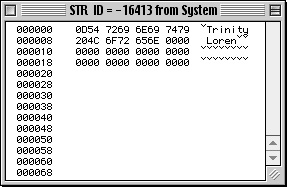Appendix: Hexidecimal Values
By: Mike Kimball - Revised: 2006-06-29 devinIntroduction
Learn how hexidecimal values work.Hexidecimal Values
Hex values are useful to know not only in ResEdit editing, but also in things like color values within HTML code. A hex value, instead of in base-10 numbering, uses an extra six letters to extend the values notated by a byte (pair of digits). You might say it is in base-16, because there are sixteen possible values each digit can have (0 to 9, A, B, C, D, E, F). However, remember that the actual value is literal, since it starts on zero, and zero has a value of zero (not "counted" as 1). Thus, A = 10, B = 11, and so on up to F = 15.So, this means that a pair works as follows:
00 = 0, 01 = 1 ... 09 = 9, 0A = 10 ... 0F = 15,
10 = 16, 11 = 17 ... 19 = 25, 1A = 26 ... 1F = 31
...
F0 = 240, F1 = 241 ... F9 = 249, FA = 250 ... FF = 255
16413 in hex Editor

Above we see the 16413 resource in the hex editor after changing the name to "Trinity Loren". The first byte is set to "0D", a value of 13, indicating the length of the name (thirteen characters including the space).
- Documentation
- Administration
- Authentication
- General Software
- Hardware
- Miscellaneous
- Multimedia
- Networking
- Operating Systems
- Outside Presentations
- Programming & Scripting
- Security
- Servers
- Short Courses
- System Deployment
- System Utilities
- What's New

